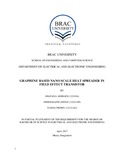| dc.contributor.advisor | Ashrafi, Avijit DasShafana | |
| dc.contributor.author | Ashrafi, Shafana | |
| dc.contributor.author | Ahnaf, Shekh Rafid | |
| dc.contributor.author | Promy, Tasfia | |
| dc.date.accessioned | 2017-08-21T06:28:14Z | |
| dc.date.available | 2017-08-21T06:28:14Z | |
| dc.date.copyright | 2017 | |
| dc.date.issued | 2017 | |
| dc.identifier.other | ID 11221016 | |
| dc.identifier.other | ID 12221109 | |
| dc.identifier.other | ID 12121162 | |
| dc.identifier.uri | http://hdl.handle.net/10361/8415 | |
| dc.description | This thesis report is submitted in partial fulfillment of the requirements for the degree of Bachelor of Science in Electrical and Electronic Engineering, 2017. | en_US |
| dc.description | Cataloged from PDF version of thesis. | |
| dc.description | Includes bibliographical references (page 71-73). | |
| dc.description.abstract | Currently the methods used to reduce the generation of heat in semiconductors are mainly Flip-chip bonding and the use of metal matrix composite. Both are not very efficient when it comes to dispersing the inert heat generated in a transistor. There is still little if not zero progress behind thermal management of a transistor in its core that is in the nanometer scale. Generally speaking, the electrical energy that is supplied to electronic devices is ultimately transformed into and dissipated as heat. This generation of heat is accompanied by a temperature rise at the heat source followed by the transport of heat to regions of lower temperature within and outside the electronics module or package. Within the package transport of heat occurs via a process of thermal conduction in the solid material making up the package. As the heat reaches the external surfaces of the package it is usually transferred to a cooling fluid (e.g., air) via a thermal convection process. In the case of lower power components thermal radiation may also play a role in transferring heat to the surrounding environment. The temperatures within the electronics package will continue to rise until the rate of heat removal from the package is equal to the rate of heat generation. It is worthwhile to note that, even if purposeful active measures were not taken to cool the package, the laws of nature or physics would prevail and limit the temperature rise. However, in most instances, the resulting temperatures would be too high. As shown in Fig: [T] based upon the results of a study conducted under a US Air Force Avionics Integrity Program, temperature was identified as the principal factor in 55% of electronic failures. In addition to the effect of temperature on electronic device reliability, it can also play an important role on CMOS circuit performance. Consequently, it is necessary to provide satisfactory cooling for electronic packages by design. Heat is generally produced inside a semiconductor, when high amounts of current is flowing. Although methods to dissipate the heat from the exterior of the packaging is available, little to no work has been done to minimize heating effect in the nanometer scale. Heat is produced by mostly Peltier conditions and other effects, which will be discussed later. Our idea is to put in a Graphene based Nano sheet inside the transistor to be used a heat spreader, which will absorb the excess heat produced and dissipate it out. Thereby improving transistor functionality. Graphene is a highly thermal conductive material, consisting of a single layer, one atom thick hexagonal lattice of Carbon atoms. Graphene’s (pure, undoped) thermal conductivity is as high as, 2000-4000 W m-1 K-1. Silicon based semiconductors have thermal conductivity of 150 W m-1 K-1. Diamond, a very popular material with excellent thermal properties has a thermal conductivity of 1000 m-1 K-1. Graphene can be said to be a cousin of Diamond. Both have Carbon as their base element, both have similar properties. However Graphene beats the race of thermal management. We have also used different versions of Graphene such as Bi-Layer, Few Layer, N-Doped and Al-Doped. These test materials have been simulated in QuantimeWiseTM, and we have showed different Figure of Merit (ZT) for different types of graphene. Other parameters such as, Seebeck Coefficient, Phonon Thermal Conductivity and Electron Thermal Conductivity have also been evaluated.
All our calculated results are analyzed and presented in an organized manner. | en_US |
| dc.description.statementofresponsibility | Shafana Ashrafi | |
| dc.description.statementofresponsibility | Shekh Rafid Ahnaf | |
| dc.description.statementofresponsibility | Tasfia Promy | |
| dc.format.extent | 73 pages | |
| dc.language.iso | en | en_US |
| dc.publisher | BRAC Univeristy | en_US |
| dc.rights | BRAC University thesis is protected by copyright. They may be viewed from this source for any purpose, but reproduction or distribution in any format is prohibited without written permission. | |
| dc.title | Graphene based nano scale heat spreader in field effect transistor | en_US |
| dc.type | Thesis | en_US |
| dc.contributor.department | Department of Electrical and Electronic Engineering, BRAC University | |
| dc.description.degree | B. Electrical and Electronic Engineering | |

